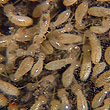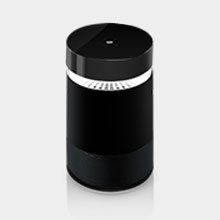防冶白蟻
TERMITES

- Dampwood Termite
Zootermopsis spp. and Neotermes spp.

- Drywood Termite
Cryptotermes spp. and Incisitermes spp.

- Formosan Termite
Coptotermes formosanus

- Subterranean Termite
Reticulitermes spp., Coptotermes spp. and Heterotermes spp.
FACTS & IDENTIFICATION INFORMATION
Termites are often called the “silent destroyer” because they may be secretly hiding and thriving in your home or yard without any immediate signs of damage. All termites consume cellulose-based plant materials. Unfortunately, all homes, regardless of their construction type, can provide cellulose food for termite infestation.
TERMITE SCIENTIFIC NAME
There are three major types of termites found in the United States: subterranean, drywood, and dampwood. They all belong to the phylum Arthropoda, the class Insecta, and the order Isoptera. There are over 2,000 different species, which all have distinct scientific names.
Three of the more common home-invading termite species are Eastern subterranean termites, Pacific dampwood termites, and Southeastern drywood termites. Their scientific names are Reticulitermes flavipes, Zootermopsis angusticollis, and Incisitermes snyderi, respectively.
APPEARANCE
Termites range from 1/4 to 1/2 an inch in length. The queens and kings are larger, capable of reaching over one inch long. The workers are typically soft-bodied and pale-colored. Flying termites, also called reproductives, have two pairs of prominent wings. Learn more about what a termite looks like
DIET
Termites are detritivores, or detritus feeders. They feed on dead plants and trees. Termites get nutrients from cellulose, an organic fiber found in wood and plant matter. Wood makes up the majority of the pests’ diet, although termites also eat other materials such as paper, plastic, and drywall. Most species prefer dead wood, but some termites feed on living trees.
Each type of termite has its own dietary preferences. Subterranean termites prefer softwoods, but may invade most species of wood. Dampwood termites generally stay close to the ground, but will choose moist, decaying wood anywhere it is found. Drywood termites are often found in attics and require little moisture in the wood they eat.
A termite’s mouth is capable of tearing pieces of woody material. This ability is what causes concern in human dwellings: while termite workers only measure approximately 1 cm to a few millimeters in length, their feeding habits are capable of causing costly damage to property. House foundations, furniture, shelves and even books are all possible feeding sites for termites. Read more about what termites eat
TERMITE HABITAT
Commonly, termites live in wooden structures, decayed trees, fallen timber, and soil. Habitats vary among species as some termites require different amounts of moisture. The pests are found in greater numbers in tropical regions where living conditions for termites is optimal.
Subterranean termites are the most abundant variety and can be found throughout the United States. Both dampwood and drywood species are generally more localized in the Southern states.
Subterranean termite homes are usually formed in soil. Within these mounds, termites build elaborate tunnel systems and mud tunnels through which they access above-ground food sources. Drywood termites live within the wood they consume and oftentimes infest walls and furniture.
When a colony has matured, winged, swarming termites can be seen around windows and doors. Winged termites are highly attracted to sources of light and are most active in springtime. After mating, these termites locate a new breeding site and create another colony, spreading infestations throughout multiple locations in the case of drywood termites.
TERMITE REPRODUCTION
In the summer months, reproductive flying termites leave their mature colonies to mate and pair off. After this, the couples lose their wings, become queens and kings, and create new colonies. Immature termites develop to fill one of three roles: workers, soldiers, or reproductives. Some species of termite queens lay millions of eggs each year. Read more about the termite
COLONY
Workers are responsible for gathering and feeding the colony members, maintaining the nest, and caring for young. Soldiers protect the termite colony using their large mandibles to fend off predators. Reproductives are the only sexually mature members of the colony, aside from queens and kings. Read more about termite colonies.
WHAT CAN YOU DO TO HELP PROTECT YOUR HOME?

Since termites are a constant threat to your home, here are some things you can do during the year to help maintain the effectiveness of The Orkin Man’s termite treatment plan. Small steps make a big difference in termite prevention and sustaining an effective termite treatment plan. Start by eliminating moisture conditions and termite food around your home. These simple steps make your home a less attractive target, helping deter termites.
ELIMINATE MOISTURE PROBLEMS
- Repair leaking faucets, water pipes, and A/C units
- Divert water from foundation
- Keep gutters and downspouts clean
- Remove excessive plant cover and wood mulch
- Get rid of standing water on roof
- Keep all vents clear and open
- Seal entry points around water and utility lines or pipes
REMOVE TERMITE FOOD SOURCES
- Keep firewood, lumber or paper away from foundation or crawl space
- Get rid of stumps and debris near house
- Place screens on outside vents
- Check decks and wooden fences for damage
- Wood on your home shouldn’t contact the soil
TERMITE WARNING SIGNS & IDENTIFICATION
Some indications you may have a termite infestation:
- A temporary swarm of winged insects in your home or from the soil around your home.
- Any cracked or bubbling paint or frass (termite droppings).
- Wood that sounds hollow when tapped.
- Mud tubes on exterior walls, wooden beams or in crawl spaces.
- Discarded wings from swarmers.






